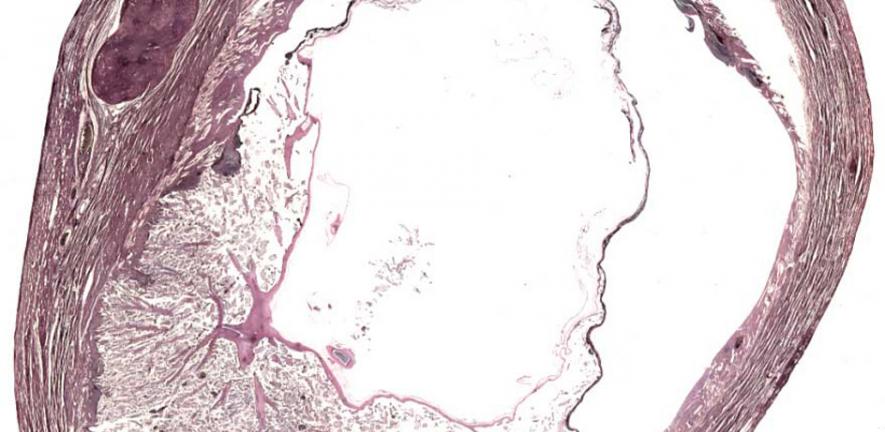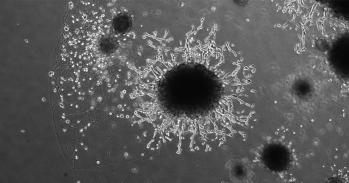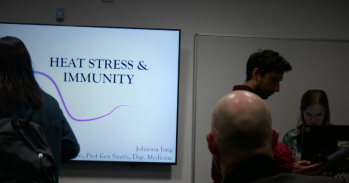
New insights into pregnancy are resulting from research on the interaction between mother and fetus at the placental interface.
New insights into pregnancy are resulting from research on the interaction between mother and fetus at the placental interface.
A fine balance exists in this ‘no-man’s-land’ – too little invasion means the fetus will be starved, too much invasion is detrimental to the mother.
Professor Ashley Moffett’s research group in the Department of Pathology studies how the immune system acts during pregnancy to establish and maintain a balance between the different needs of the mother and her baby as it develops. If this is defective, major problems of pregnancy arise, including recurrent miscarriage, low birth weight, stillbirth and pre-eclampsia.
Degrees of invasion
As many as 3–10% of births worldwide are affected by pre-eclampsia, a complication that is particularly common in first pregnancies. Pre-eclampsia develops suddenly towards the end of pregnancy and progresses rapidly, causing death of the mother and her baby unless there is delivery by emergency Caesarean section. The condition arises when the placenta (which is derived from the fetus) fails to invade deeply into the uterus, so that the proper connections with the uterine arteries that provide essential oxygen and nutrients to the fetus are not established. A fine balance exists in this ‘no-man’s-land’ – too little invasion means the fetus will be starved, too much invasion is detrimental to the mother.
Placental trophoblast cells are at the interface between the placenta and uterus; as they migrate through the uterine wall they come into contact with cells of the maternal immune system. The maternal cells that appear to be especially important in regulating the degree of invasion are uterine natural killer (uNK) cells. Work in Professor Moffett’s lab has been looking at what determines which way the balance tips and how uNK cells might both assist and hinder placentation.
Mix and match
The group’s focus has been on the receptors on uNK cells that recognise fetal trophoblast cells. These receptors, known as KIR, are inherited as a family of genes that differ widely between different individuals: in other words they are polymorphic. The molecules on the invading fetal trophoblast cells recognised by KIR receptors are called MHC and these are also highly polymorphic. Indeed, MHC and KIR are encoded by the two most variable polymorphic gene systems known in humans.
Professor Moffett’s lab has typed the KIR genes in women with pre-eclampsia and compared them with those of mothers with normal pregnancies. Results show that particular combinations of maternal KIR genes and fetal MHC genes are associated with pre-eclamptic pregnancies. Similar findings were found in women with repeated early miscarriages where the placenta fails to establish proper connections with the uterine arteries early in gestation. How these genetic findings translate into a biological understanding of placentation is now under active investigation.
Brainy humans walk upright
Curiously, pre-eclampsia is unique to humans and is absent even in the great apes; is this related to the particular type of placenta that humans have evolved? There are selective pressures associated with both the constraints imposed on the pelvis by walking upright and the acquisition of large brains, which requires a longer period of development in the uterus. These specifically human attributes have placed unique demands on the system that regulates the balance in utero between the mother and her fetus. Comparison with their primate relatives indicates that the human KIR and MHC gene families have changed and expanded since humans evolved. Part of this rapid change may have been dictated by the potential dangers of human reproduction – fine-tuning is needed to achieve a birth weight not too large to prevent delivery through the female pelvic outlet and yet large enough for the baby to survive once born.
For more information, please contact Professor Ashley Moffett (am485@cam.ac.uk) at the Department of Pathology. This research is funded by the Wellcome Trust and the Centre for Trophoblast Research.
This work is licensed under a Creative Commons Licence. If you use this content on your site please link back to this page.





